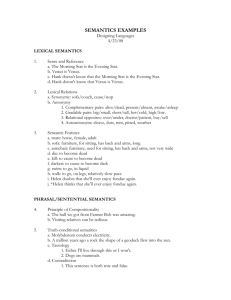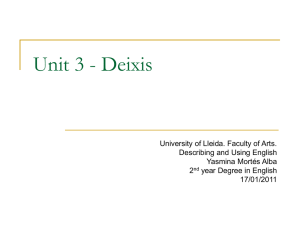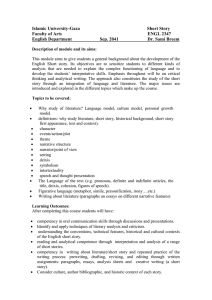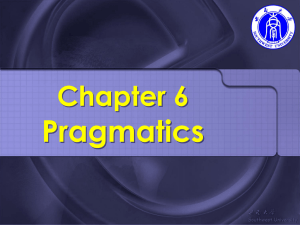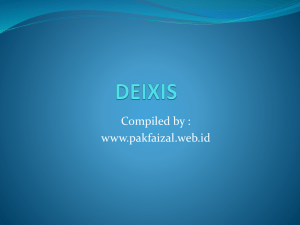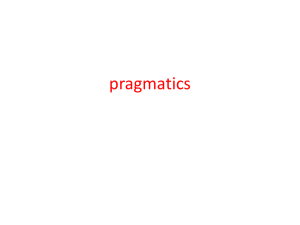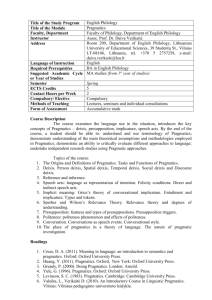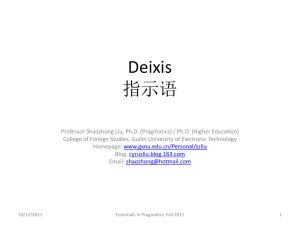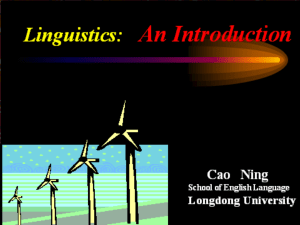AN ANALYSIS OF DEIXIS USED IN “THE KING`S SPEECH” FILM`S
advertisement
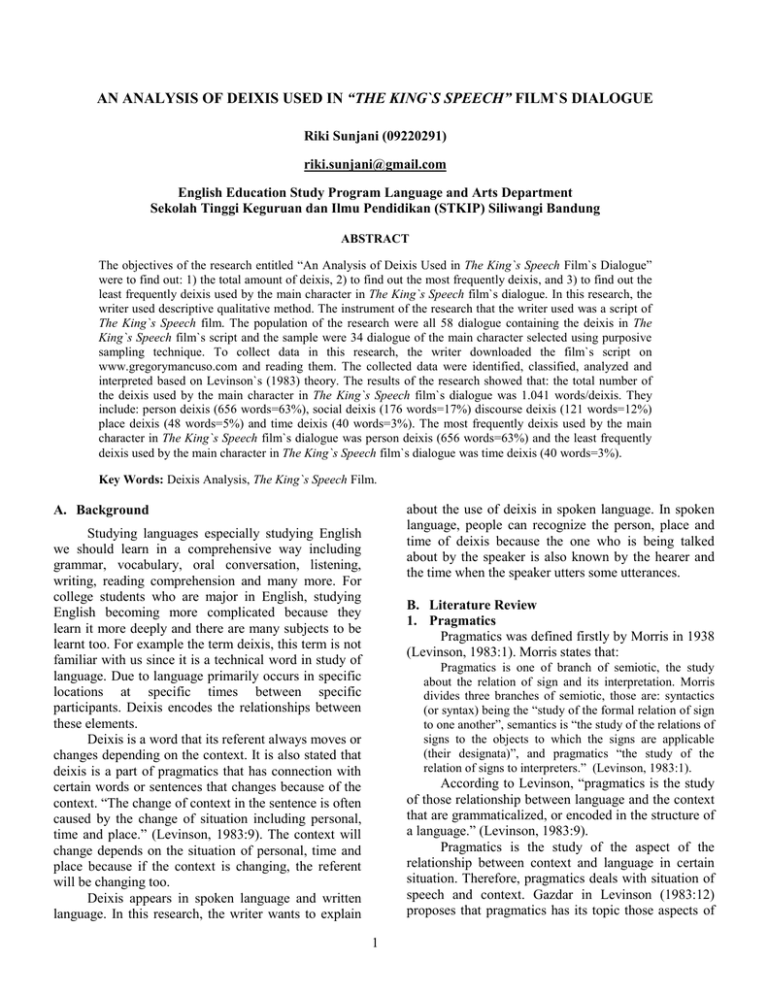
AN ANALYSIS OF DEIXIS USED IN “THE KING`S SPEECH” FILM`S DIALOGUE Riki Sunjani (09220291) riki.sunjani@gmail.com English Education Study Program Language and Arts Department Sekolah Tinggi Keguruan dan Ilmu Pendidikan (STKIP) Siliwangi Bandung ABSTRACT The objectives of the research entitled “An Analysis of Deixis Used in The King`s Speech Film`s Dialogue” were to find out: 1) the total amount of deixis, 2) to find out the most frequently deixis, and 3) to find out the least frequently deixis used by the main character in The King`s Speech film`s dialogue. In this research, the writer used descriptive qualitative method. The instrument of the research that the writer used was a script of The King`s Speech film. The population of the research were all 58 dialogue containing the deixis in The King`s Speech film`s script and the sample were 34 dialogue of the main character selected using purposive sampling technique. To collect data in this research, the writer downloaded the film`s script on www.gregorymancuso.com and reading them. The collected data were identified, classified, analyzed and interpreted based on Levinson`s (1983) theory. The results of the research showed that: the total number of the deixis used by the main character in The King`s Speech film`s dialogue was 1.041 words/deixis. They include: person deixis (656 words=63%), social deixis (176 words=17%) discourse deixis (121 words=12%) place deixis (48 words=5%) and time deixis (40 words=3%). The most frequently deixis used by the main character in The King`s Speech film`s dialogue was person deixis (656 words=63%) and the least frequently deixis used by the main character in The King`s Speech film`s dialogue was time deixis (40 words=3%). Key Words: Deixis Analysis, The King`s Speech Film. about the use of deixis in spoken language. In spoken language, people can recognize the person, place and time of deixis because the one who is being talked about by the speaker is also known by the hearer and the time when the speaker utters some utterances. A. Background Studying languages especially studying English we should learn in a comprehensive way including grammar, vocabulary, oral conversation, listening, writing, reading comprehension and many more. For college students who are major in English, studying English becoming more complicated because they learn it more deeply and there are many subjects to be learnt too. For example the term deixis, this term is not familiar with us since it is a technical word in study of language. Due to language primarily occurs in specific locations at specific times between specific participants. Deixis encodes the relationships between these elements. Deixis is a word that its referent always moves or changes depending on the context. It is also stated that deixis is a part of pragmatics that has connection with certain words or sentences that changes because of the context. “The change of context in the sentence is often caused by the change of situation including personal, time and place.” (Levinson, 1983:9). The context will change depends on the situation of personal, time and place because if the context is changing, the referent will be changing too. Deixis appears in spoken language and written language. In this research, the writer wants to explain B. Literature Review 1. Pragmatics Pragmatics was defined firstly by Morris in 1938 (Levinson, 1983:1). Morris states that: Pragmatics is one of branch of semiotic, the study about the relation of sign and its interpretation. Morris divides three branches of semiotic, those are: syntactics (or syntax) being the “study of the formal relation of sign to one another”, semantics is “the study of the relations of signs to the objects to which the signs are applicable (their designata)”, and pragmatics “the study of the relation of signs to interpreters.” (Levinson, 1983:1). According to Levinson, “pragmatics is the study of those relationship between language and the context that are grammaticalized, or encoded in the structure of a language.” (Levinson, 1983:9). Pragmatics is the study of the aspect of the relationship between context and language in certain situation. Therefore, pragmatics deals with situation of speech and context. Gazdar in Levinson (1983:12) proposes that pragmatics has its topic those aspects of 1 Deixis is clearly a form of referring that is tied to the speaker`s context, with the most basic distinction between deictic expressions being ‘near speaker’ versus ‘away from speaker’. In English, the ‘near speaker’, or proximal terms, are ‘this’, ‘here’, ‘now’. The ‘away from the speaker’, or distal terms, are ‘that’, ‘there’ ‘then’.” (Yule, 1996:9). the meaning of utterances which cannot be accounted for by straightforward reference to the truth conditions of the sentences uttered, then he puts crudely that pragmatics = meaning – truth conditions. Thus, there is no meaning in pragmatics if there is no context. Context helps the speakers to know what the real meaning of utterances is. From the theories above we can conclude that pragmatic is the study of invisible meaning, that is how to recognize, the underlined meanings which are not apparently said or written. 2. Context From what has been said in the pragmatics definition, that context has an importance function for pragmatics or linguistics terms. The importance of context in figuring out ambiguities in spoken or written language, context also considered as the situation in the conversation. Jacob L. Mey states that the context as a part which cannot be separated from pragmatic discussions, Mey argued that: The referent of deixis will be easily known if the speaker and hearer know the context. In addition, context gives a comprehensive explanation about the participants, setting (time or place) and the end of conversation. It is believed that there are no languages without deixis because language is full of such deictic terms. To give a clear picture about deixis, these are two examples of deixis: a. “I am terrible in dance” b. “I found this thing at the yard” In the first utterance (a), the word “I” is used to refer to the speaker who utters it, but it is used to refer to another speaker when someone else utters it. Thus, it can be seen that even the word “I” in (a) does not change but the referent enable to changes depending on who utters it. In example (b), there are two deixis in one utterance. The first word “I” is used to refer to the speaker who utters it and the second word “this” refer to a certain thing that has found by the speaker who utters it. Thus, in this utterance the speaker and the thing be able to change depend on the context. Deixis can be identified through a number of grammatical features such as: Context is a dynamic, not a static concept: it is to be understood as the continually changing surroundings, in the widest sense, that the enable the participants in the communication process to interact, and in which the linguistic expressions of their interaction become intelligible. (Mey, 2001:39). From the concepts above, it can be seen that people cannot understand the meaning of the utterance without knowing the background of the text in the utterance or speech event. 3. Deixis 1) Definition of Deixis Deixis is a word used to indicate something in many referents whether in space, time, or social context. Table 1 Example of Deixis Deixis is a word borrowed from the Greek word for pointing or indicating, and has as prototypical or focal exemplars the use of demonstratives, first and second person pronouns, tense, specific time and place adverbs like now and here, and a variety of other grammatical features tied directly to the circumstances of utterance. (Levinson, 1983:54) Furthermore, Levinson (1983:54) propose the essentially deixis concerns the ways in which languages encode or grammaticalize features of the context of utterance or speech event, and thus also concerns ways in which the interpretation of utterances depends on the analysis of that context of utterance. George Yule (1996) in Pragmatics states that deictic (deixis) expressions are also sometimes called indexical. Moreover Yule states the deixis as follow: Demonstratives This, that, these, those First and second person pronouns I, you, we Adverbs of time Now, then Adverbs of place Here, there Motion verbs Come, go, take, fetch Tense markers Yesterday, tomorrow Source:http://www.slideshare.net/teacher14/deixispresentation-final-4th-dec-2012 2 2) Kinds of Deixis There are five types of deixis. They are: person deixis, time deixis, place deixis, social deixis and discourse deixis. (Levinson, 1983:62) Person Deixis Place Deixis Expression used to point a person e.g. I, you, we . . . Expression used to point to place e.g. here, there, . . . b) Time Deixis Absolutely every deictic expression are inextricably linked from the other deixis, they always linked. As stated by Cummings (2005:24): From personal pronouns to vocative, the establishment of participant role (speaker, hearer, etc.) in a speech situation is significantly shaped by features of the social relationship between participants and by features of the social setting. A similar interdependence of deictic categories is evident in the case of time deixis. for example, the referent of “last week” in the utterance “I left last week” varies with the point in time that a speaker produce this utterance. Discourse Deixis Expression used to refer to an earlier or a forthcoming segment of discourse E.g. the previous, next, ... Time Deixis Social Deixis Expression used to refer to time e.g. now, then, yesterday, last . . Expression used to show respect e.g. your royal highnes, your majesty . . . Time deixis refers to the time which relative to the time of speaking or an utterance spoken. On the other hand, this point is the moment of utterance. “Time deixis makes ultimate reference to participant-role, so it is important to distinguish the moment of utterance from the moment of reception.” (Levinson, 1983:73) Time deixis will be easily known if the speaker and hearer understand the time they utter and the time they mean. c) Place Deixis Place deixis is the place relation between the speaker and thing that speaker mean. According to Levinson (1983:62), “place deixis concern the encoding of spatial locations relative to the location of the participants in the speech.” Place or location can be deixis if that place or location can be seen from the location of the people who are doing communication in speech event. d) Social Deixis “Social deixis concerns the encoding of social distinctions that are relative to participant-roles, particularly aspects of the social relationship holding between speaker and addressee (s) or speaker and some referent.” (Levinson, 1983:63). Social deixis is the used of different deictics to express social distinction. It means that social deixis is where the form of word used to indicate the relative social status of the speaker and the hearer. The example is the difference between formal and polite forms. e) Discourse Deixis “Discourse deixis has to do with the encoding of reference to portions of the unfolding discourse in which the utterance (which includes the text referring expression) is located.” (Levinson, 1983:62) Figure 1 Kind of Deixis (Source: Alan Cruse, 2000) a) Person Deixis Person deixis is a word that refers to someone in certain context of the utterance. Levinson (1983:62) states: Personal deixis concerns the encoding of the role of participant in the speech event in which the utterance in question is delivering. The category first person is the grammaticalization of the speaker’s reference to himself, second person the encoding of the speaker`s reference to one or more addresses, and third person the encoding of reference to persons and entities which are neither speaker nor addresses of the utterance in question”. Personal Deixis is deictic reference to the participant role of reference, such as the speaker, the addressee, and referent that are neither speaker nor addressee. There are some grammatical words are included into person deixis, such as: subject pronoun (I, you, they, we, he, she, it), object pronoun (me, you, him, her, it, us, them), possessive adjective (my, your, his, her, its, our, their), possessive pronoun (mine, yours, his, hers, ours, and theirs), and reflexive pronoun (myself, yourself, himself, herself, itself, ourselves, yourselves, themselves). 3 Cummings states that “discourse, or text, deixis concerns the use in discourse deixis, linguistic expressions are used to refer to some part of the wider discourse (either a written text and/or an oral text) in which these expressions occur.” (Cummings, 2005:28) 4. Film a) Film Definition Films/movies are cultural artifacts created by specific cultures, which reflect those cultures, and, in turn, affect them. Film is considered to be an important art form, a source of popular entertainment and a powerful method for educating or indoctrinating citizens. The visual element of cinema gives motion pictures a universal power of communication. Some films have become popular worldwide attractions by using dubbing or subtitles that translate the dialogue. (http://www.filmsite.org/filmgenres.html) b) Summary of The King`s Speech film This film tells the story a man who became King George VI, the father of Queen Elizabeth II. In 1925, the Duke of York is stammer and has troubles to speak to the public. His wife Elizabeth seeks the treatment of the speech therapist Lionel Logue that follows unconventional methods and relationship, and Bertie gives up the treatment on the first day. However, after listening to the session that was recorded by Lionel, Bertie returns to the treatment. In the mid 30's, the Duke of York was forced to assume the throne of England as King George VI due to the abdication of his older brother King Edward VIII. Immediately after, there is a crisis in the government and England declares war to Germany. King George VI needs to make a speech to his compatriots, and his friend Lionel helps him using an unorthodox technique. C. Research Methodology 1. Research Method In this research, the researcher used a descriptive qualitative method, that is used in the case study, document analysis and co-relation research. William Wiersma (1991:14) states that “qualitative research is context-specific with the researcher`s role being one of inclusion in the situation.” Crowl also states “a qualitative method is used to examine questions that can be best answered by verbally describing how participants in a study perceive and interpret various aspect of their environment.” (Crowl, 1996:10) 2. Instrument of the Research Instrument research that used in this research is the researcher itself (human instrument). It means the researcher as an instrument that involved in this research for doing research and finding data. The researcher is helped by table matrix for collecting and analyzing data. Table matrix is kind of data card that used by researcher to put the data, to classify, to identify and to analyze the data. (See figure 2) 3. Research Site and Subjects In this research, the researcher choose the population and sample from the script of film, that is some dialogue of the film`s script or all dialogue of main charater in The King`s Speech film. As Thomas Crowl states that “Populations are groups consisting of all people to whom a researcher wishes to apply the findings of a study”. Crowl also states that “sample are subsets of people used to represent populations.” (Crowl, 1996:8) The researcher used purposive sampling to take the sample of the data in this research. According to Alwasilah “purposive sampling is the way to decide or to choose sample depends on the result or way that hes been done.” (Alwasilah, 2002:27). McMillan and Schumacher also states, “Purposeful sampling is done to increase the utility of information obtained from small samples” (McMillan & Schumacher, 2001:401) Relating to the explanations above, the population of the research were all 58 dialogue containing the deixis in The King`s Speech film`s script and the sample were 34 dialogue of the main character selected using purposive sampling technique. 4. Data Collection In conducting this research, the researcher used the observation technique method to collect data. Which is “observation enables to draw inferences about someone`s meaning and perspective that couldn`t obtain by relying exclusively on interview data.” (Maxwell, 1996:76) Alwasilah also states “observation enables the researcher to draw conclusion about meaning and respondent`s point of view, incident or data analyzing.” (2002:155). Consequently, by doing the observation to collect the data during three months from March to June 2013 and take home as a place for doing the research, the researcher saw how the theory was in use while the data was analyzed. The researcher used several steps to collect the data: 1. First step the researcher watched The King`s Speech film. 2. The researcher observed the utterances in the film`s dialogue. 3. The researcher found the film script of The King`s Speech on www.gregorymancuso.com 4. The researcher compared the dialogue in the film to the film script. 4 5. The researcher identified the utterances in the whole of film`s dialogue that contains deixis. 6. The researcher separated some dialogues that contains the main characters on The King`s Speech film. 7. The researcher put the data into the table matrix. The table matrix helped the researcher to classify, to identify and to analyze the data. Below is the figure of table matrix for collecting data: No. Context Text Types of Deixis Person Deixis Time Deixis Place Deixis Social Deixis c. Analyzing The researcher analyzed the data by exploring and describing the meaning of the use of deixis in the film`s dialogue and by using content analysis. The purpose of the content analysis is to analyze the content of some pieces of communication. d. Drawing After analyzing the data, the writer delineates the data into five kinds of deixis. They are person deixis, time deixis, place deixis, social deixis and discourse deixis and after that the researcher draw the whole numbers of deixis from the data, describe meaning and make the conclusion. Meaning Discourse Deixis D. Findings and Discussion The King’s Speech film had 100 scenes and had 58 conversations that contained kinds of deixis. Whereas there are 34 conversations of main character and 34 numbers of table matrix. The total number of the use of deixis by main character in The King`s Speech film`s dialogue was 1.041 words, which were divided into five kinds of deixis. These were the five kinds of deixis found in The King`s Speech film`s dialogue. Person deixis was 656 words, time deixis was 40 words, place deixis was 48 words, social deixis was 176 words, and discourse deixis 121 words. Here the finding of kind`s deixis in The King`s Speech film`s dialogue and also the result of how many deixis and its meaning. Figure 2 Table Matrix 5. Data Analysis Analysis in the research is about the search for explanation and understanding the meaning. According to Blaxter et al. (1996:186) “analysis is meant to be a rigorous process, using data that has been carefully produced and managed.” According to Maxwell (1996:78) “data analysis is probably the aspect of qualitative research that most clearly distinguishes it from experimental and survey research.” From the theories that was explained above, the researcher assumed that the appropriate method to analyze the data in this research used descriptive analysis, to classify kinds of deixis, find out how many deixis in the film`s dialogue and to describe its meanings. 6. Research Procedures In the research procedures the writer explains step by step of analyzing the data. The researcher conducted some techniques to analyze the data by arranging some particular steps as follows: a. Classifying The researcher clasified the dialogues into two parts, that is the dialogue of the main character and the dialogue without the main character of The King`s Speech film. b. Describing the Context of the Conversation The researcher described the context of the conversation including the participants, setting, time and place based on the context from The King`s Speech film`s dialogue. Table 2 The finding of kind’s deixis No 1 2 3 4 5 Kind of Deixis Number of Data Percentage Person Deixis 656 63% Time Deixis 40 17% Place Deixis 48 12% Social Deixis 176 4% Discourse Deixis 121 3% Total Number 5 1.041 100% Alwasilah, A. Chaedar. From Local to Global: Reinventing Local Literature Through English Writing Classes. Bandung: Teflin Journal, Indonesia University of Education. Arifin, Tajul. 2012. Analyzing English as a Foreign Language (EFL) Classroom Interaction. Apple3l Journal (1) Blaxter, Loraine et al. 1996. How to Research. Buckingham-Philadelpia: Open University Press. Crowl, K. Thomas. 1996. Fundamentals of Educational Research (Second Edition). USA: Brown & Benchmark Publisher. Cruse, Alan. 2000. Meaning in Language: An introduction to Semantics and Pragmatics. New York: Oxford University Press. Cummings, Louise. 2005. Pragmatics: A multidisciplinary Perspective. New Jersey: Edinburgh University Press. Grundy, P. 2008. Third Edition: Doing Pragmatics. London: Hodder Education (Part of Hachette Livre UK) Halliday, M.A.K & Ruqaiya, H. 1985. Language, Context and Text: Aspect of Language in a social-Semiotic Perspective. Melbourne: Deakin University Press Huang, Yan. 2007. Pragmatics. New York: Oxford University Press. Levinson, Stephen C. 1983. Pragmatics: Cambridge, England: Cambridge University Press Maxwell, Joseph A. 1996. Qualitative Research Design: An Interactive Approach. California: SAGE Publication inc. McMillan James H. & Shumacher Sally. (2001). Research in Education: A Conceptual Introduction. New York: Longman. Mey, Jacob L. 2001. Second Edition: Pragmatics An Introduction. Malden, Massachusetts: Oxford University Press Wiersma, William. 1991. Research Methods in Education: An Introduction fifth Edition. Allyn and Bacon: The University of Toledo Yule, George. 1996. Pragmatics. Oxford: Oxford University Press. Dirks, Tim. In Filmsite.org, 2013. Film Site. [On Line] Retrieved May 8, 2013 and it available at http://www.filmsite.org/filmgenres.html. Mancuso, Gregory. 2011. The King Speech’s film Script Written by David Seidler pdf. [On Line] Available on the internet at http://gregorymancuso.com/2011/04/screenplaysthe-king`s-speech-by-david-seidler/#more-1512 (Accessed on February 26, 2013) E. Conclusion and Suggestion 1. Conclusion Based on the result of the research that had been obtained and analyzed, some conclusion can be drawn as follows: a. The King`s Speech film`s dialogue had 58 conversations that contained kinds of deixis. Whereas there are 34 conversations of main character that contained kinds of deixis and 34 numbers of tables matrix that used to analyze them. The total number of the use of deixis by main character in The King`s Speech film`s dialogue was 1.041 words, which were divided into five kinds of deixis. Those were person deixis (656 words=63%), social deixis (176 words=17%), discourse deixis (121 words=12%) place deixis (48 words=5%) and time deixis (40 words=3%).There were five kinds of deixis found in The King`s Speech film`s dialogue that used by main character. b. The result of this research showed kinds of deixis that the most frequently used by main character in The King`s Speech film`s dialogue was person Deixis (656 words=63 %), and; c. Kinds of deixis that the least frequently used by the main character in The King`s Speech film`s dialogue was time deixis (40 words=3 %). 2. Suggestion a) For students who are major in English Department, studying English not only study about four skills. Moreover, we have to know about structure, meaning, context, and another literary. b) It is better for other researcher to analyze the use of deixis in each kind like the use of person deixis, time deixis, place deixis, social deixis and discourse deixis. Thus, this study can be enlarged and developed by other researchers who are interested in analyzing the use of deixis and its meaning. c) It is better for other researcher who will conduct study in pragmatics fields to take analysis about the use of deixis in spoken language or written language. On the other hand, they may analyze the use of deixis in language not only in the movie, but also in another object, which may be used as the object of the research. F. BIBLIOGRAPHY Alwasilah, A. Chaedar. 2002. Pokoknya Kualitatif: Dasar-Dasar Merancang dan melakukan Penelitian Kualitatif. Jakarta: PT Dunia Pustaka Jaya. 6 7
